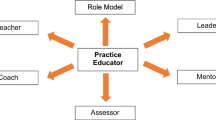Abstract
Objective: To assess the educational outcomes of training junior medical students in an eight-week combined ambulatory/inpatient rotation compared with those of training exclusively on inpatient services.
Design: Participants were randomly assigned to one of three groups: those who volunteered for the ambulatory/inpatient rotation and were randomly selected; those who volunteered and were not selected; and those who did not volunteer.
Setting: University-based internal medicine (IM) inpatient services and community-based clinics and private practices.
Participants: Seventy-five third-year medical students taking the required eight-week IM clerkship.
Intervention: Assessment included both pre- and posttest measurement of students’ knowledge of general internal medicine and a profile of the types of patient problems seen by students in ambulatory settings.
Results: While students’ general medicine knowledge scores increased significantly from pre- to posttest (p<0.001), there was no significant difference in scores between the ambulatory/inpatient and exclusive inpatient groups. Patient log data indicated notable differences in the diagnostic compositions of students’ patient loads. For instance, 38% of the ambulatory diagnoses were infectious disease, neurologic, endocrine, rheumatologic, or dermatologic problems, and another 15% were non-IM (e.g., obstetric/gynecologic; ear, eye, nose, and throat) problems. Only 24% of the inpatient diagnoses reflected these specialty areas.
Conclusions: Ambulatory training did not significantly affect students’ knowledge gain compared with that for exclusive inpatient training, but student evaluations of the rotation plus patient log data suggested that ambulatory training can provide a more complete view of general medicine practice than can exclusive inpatient training.
Similar content being viewed by others
References
Schroeder SA. Expanding the site of clinical education: moving beyond the hospital walls. J Gen Intern Med. 1988;3(M/A suppl):S5-S14.
Gruppen LD, Wisdom K, Anderson DS, Woolliscroft JO. An assessment of the impact of ambulatory care education of third-year medical students. Acad Med. 1991;66(Sept suppl):S55-S57.
Woolliscroft JO, Schwenk TL. Teaching and learning in the ambulatory setting. Acad Med. 1989;64:644–8.
Perkoff GT. Teaching clinical medicine in the ambulatory setting: an idea whose time may have finally come. N Engl J Med. 1986;314:27–31.
Muller S (chairman). Physicians for the Twenty-first Century: Report of the Project Panel on the General Professional Education of the Physician and College Preparation for Medicine. J Med Educ. 1984;59(Part 2).
Schwartz MD, Linzer M, Babbott D, et al. Medical student interest in internal medicine: initial report of the Society of General Internal Medicine Interest Group Survey on factors influencing career choice in internal medicine. Ann Intern Med. 1991;114:6–15.
Abbott AV, Lee PV. Medical student education in ambulatory care. Acad Med. 1989;64(suppl 2):S9-S15.
Petersdorf RG. Restructuring clinical education. Acad Med. 1990;65:558.
Harris IB, Watson K, Howe R. Development and evaluation of a required ambulatory medicine clerkship. Acad Med. 1991;66:511–2.
Carmines EG, Zeller RA. Reliability and validity assessment. Beverly Hills, CA: Sage Publications, 1979.
New challenges in resident education. Proceedings of a symposium sponsored by the Society of General Internal Medicine. J Gen Intern Med. 1990;5(J/F suppl).
Graettinger JS. Internal Medicine in the National Resident Matching Program 1987: the Ides of March. Ann Intern Med. 1988;108:101–15.
Feltovich J, Mast TA, Soler NG. Teaching medical students in ambulatory settings in departments of internal medicine. Acad Med. 1989;64:36–41.
Author information
Authors and Affiliations
Additional information
The results of this study were briefly reviewed as part of an invited roundtable discussion at the American Educational Research Association’s annual meeting, April 1991, Chicago, Illinois.
Supported by a grant from the Region V Ohio Area Health Education Center.
Rights and permissions
About this article
Cite this article
Butterfield, P.S., Libertin, A.G. Learning outcomes of an ambulatory care rotation in internal medicine for junior medical students. J Gen Intern Med 8, 189–192 (1993). https://doi.org/10.1007/BF02599265
Issue Date:
DOI: https://doi.org/10.1007/BF02599265




